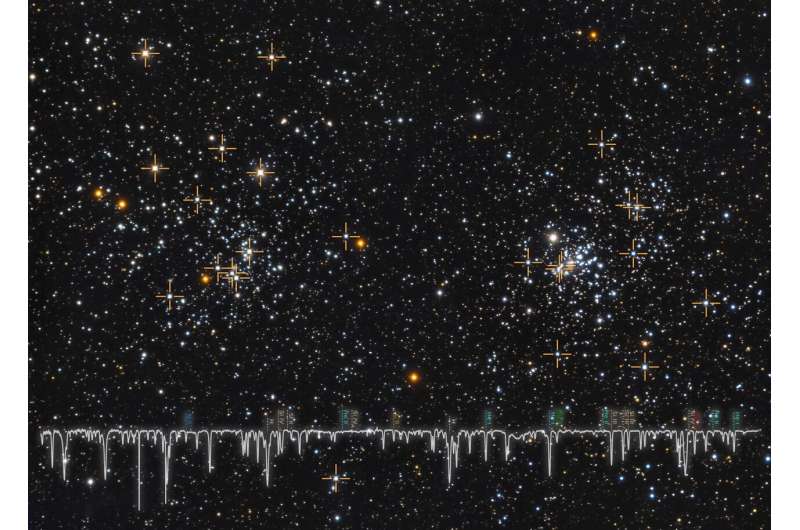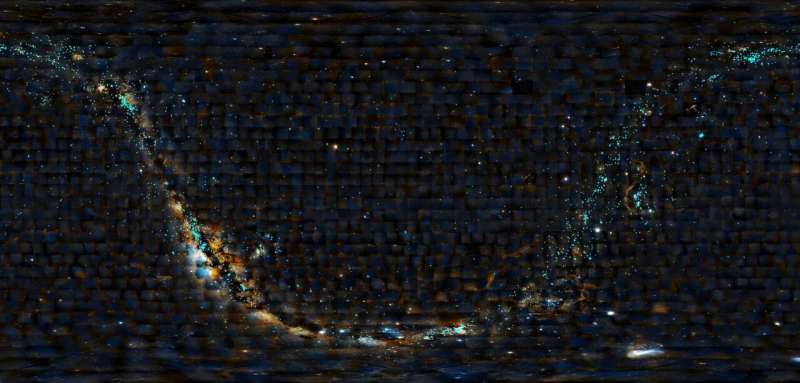This article has been reviewed according to Science X's editorial process and policies. Editors have highlighted the following attributes while ensuring the content's credibility:
fact-checked
peer-reviewed publication
trusted source
proofread
Numerous blue supergiants observed in detail

Stars are the basic elements of construction of galaxies, and therefore of the observable universe. Among the different types of stars there are some whose mass is more than eight times the mass of the sun; these are termed massive stars, and their intense radiation and powerful stellar winds make a great impact on the surrounding interstellar medium.
In their interiors they produce elements heavier than hydrogen and helium which are crucial for the chemical evolution of the galaxies and eventually for the appearance of life. In addition, after their deaths as supernovae they produce neutron stars and stellar mass black holes. All of this implies that their nature and evolution are critical for Astrophysics.
In this context blue supergiants is the term used to define those massive stars that are in an intermediate stage of their lives, a critical time, which could be described as "stellar adolescence," which will determine the rest of their lives and their final fates. Given the complexity of this evolutionary phase, previous research—based on samples of a few tens of these stars—has not managed to obtain sufficient information to understand them in detail.
In a study published in Astronomy & Astrophysics, observations were taken of some 750 blue supergiant stars in an area within 6,500 light years of Earth, which makes this one of the most complete and highest quality samples obtained. The IACOB project has spent over 15 years obtaining spectra (which are the fingerprints of stars) of high quality and high resolution of massive stars. This includes an exhaustive search for blue supergiants in the Milky Way in order to examine a large majority of them. These observations were mainly carried out with the NOT and Mercatortelescopes at the Roque de los Muchachos observatory on the island of La Palma.

"The analysis of this sample," explains Abel de Burgos Sierra, a researcher at the IAC and the ULL, and first author of the article, "will allow us to tackle some of the questions about the evolutionary nature and the physical properties of these objects which have gone for decades without solutions, because they were less well known than other types of stars with less mass, even though they are important in many fields of modern astrophysics."
To choose the sample, a new method of flagging has been used based on an easily identifiable tracer in the spectra of these stars (the shape of the profile of the H-beta line). Using a simple measurement, this method allowed the rapid and effective identification of stars within a specific range of temperature and surface gravity. In using this method, the researchers did not need to derive these quantities using the usual method of spectral analysis using complex model stellar atmospheres.
"This will be very important for identifying these types of stars when the next major spectroscopic surveys of massive stars such as WEAVE-SCIP from the Roque de los Muchachos or 4MIDABLE-LRfrom La Silla, in Chile, start to observe thousands of spectra of the stars in our galaxy every night during the coming five years," said Sergio Simón-Díaz, and IAC researcher, a co-author of the article and principal investigator of the IACOB project (an international collaboration led by the IAC, whose aim is to produce the largest database ever of the spectra of massive stars in the Milky Way).
The next step, in which De Burgos is already working as part of his doctoral thesis, is to obtain accurate data about the physical parameters (mass, temperature, luminosity) and the chemical abundances (He, C, N, O, Si) for the sample of 750 blue supergiants. "This will help to answer some of the most interesting still unanswered questions which will give us a better understanding of this 'adolescent phase' of massive stars," concludes Miguel A. Urbaneja, a researcher at the University of Innsbruck and a co-author of the article.
More information: A. de Burgos et al, The IACOB project, Astronomy & Astrophysics (2023). DOI: 10.1051/0004-6361/202346179
Journal information: Astronomy & Astrophysics
Provided by Instituto de Astrofísica de Canarias




















